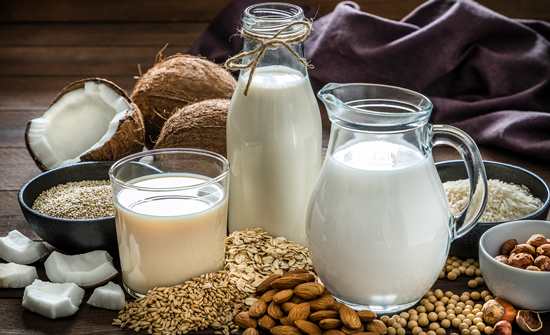
Shopping in the dairy section of most grocery stores is enough to make your head spin. Gone are the days of three simple milk choices. With the rising demand for dairy alternatives, the sheer number of options can be confusing. The global dairy alternatives market is estimated to be valued at $22.6 billion in 2020 and is projected to reach $40.6 billion by 2026. With this kind of demand, it makes sense that we see an increasing number of options on the shelf.
People have multiple reasons for wanting to try out a new kind of milk alternative. Some may have a milk allergy or developed a lactose intolerance to traditional cow's milk. Others may want to reduce potential exposure to hormones, change things up for dietary reasons or have environmental concerns.
Whole cow's milk remains a staple food item for many households. The health benefits pack a punch, including 8g of protein, 8g of fat, 350mg of potassium, 276mg of calcium and 136 calories per serving. But are milk substitutes healthy? Let's look at a snapshot of the pros and cons, along with five popular milk substitutes.
General pros and cons of milk substitutes (non-dairy beverages)
Pros:
- Increased ease of finding nondairy options
- Calorie count is often lower than cow's milk
- Wide variety of flavors and consistencies available
- Flexibility in drinking and baking
- Weight loss or allergy benefits
Cons:
- Many milk substitutes are low in protein
- Not all milk substitutes fortify with vitamin D and calcium, essential for bone health
- Some milk substitutes contain thickener, salt or sweeteners, which can trigger inflammation and add calories
- Supplementing your diet is often necessary to get adequate protein, calcium and other essential vitamins or minerals.
- Milk substitutes generally cost more than cow's milk
Soy milk
Soy milk is made by soaking soybeans and grinding them with hot water. One cup of unsweetened has about 8g of protein, 5g of fat, 450mg of calcium, and 110 calories. "Personally, I'm a huge fan of soy milk," says Kim Sharp, MMN, MNT, RDN, Nebraska Medicine nutrition therapist. "It has a similar protein content to whole milk but has fewer calories and grams of fat." If you are concerned about overall soy consumption, potential side effects or are allergic to soy; you may want to pass.
Nut milks
Nut milks can include almond, cashew, macadamia and other types of nuts. They are produced by soaking the nuts in water, draining, pureeing and blending them with hot water. Some will incorporate flavors or added vitamins and minerals. The upside of unsweetened nut milk is that they typically have fewer calories and fat grams. The downside? Low in protein and macronutrients. For example, almond milk may be popular but only contains 1 gram of protein per 8 ounces, while macadamia nuts are a good source of vitamins A and E.
Oat milk
Gaining in popularity, oat milk tends to have a bit more protein than nut milks at about 4 grams per serving. In addition to the benefit of several micronutrients, oak milk can be a better option for those looking for extra protein. However, it doesn't contain many healthy fats and tends to have more carbs and calories than other milk substitutes. "Oat milk has less protein than cow's milk, but it does have a bit of soluble fiber to it, which can help with lowering cholesterol levels," says Sharp.
Rice milk
Rice milk has a thin, light texture with a nutty profile some people prefer. Because it's made with a grain, however, it's often higher in carbs, sugar and calories than other milk substitutes. Rice milk can be an excellent nondairy alternative if you have allergies to soy, dairy or nuts, but be aware that it is also low in protein (1g per cup), vitamins and minerals.
Coconut milk
Produced from the white flesh of mature coconuts, some choose coconut milk for the texture and taste. Pros: low in cholesterol and sodium, higher in vitamin B12 and potassium. Cons: zero protein, high in saturated fats and is generally lower in nutritional value.
If you decide to switch to dairy-free milk, think about your nutritional needs and goals. Experiment to see what works for you and consider the pros and cons. Don't forget to read the label for potential additives that may hide unwanted sugars or sodium. If your chosen substitute lacks in one area or another, round out your daily intake of essential vitamins and minerals with an additional food source or supplement.



